Farmers’ Perception of Ecosystem Services Provided by Historical Rubber Plantations in Sankuru Province, DR Congo
Abstract
:1. Introduction
2. Methodology
2.1. Study Area
2.2. Data Collection
2.2.1. The Selection of Villages and Determination of the Sample Size Based of the Following Criteria
2.2.2. Characteristics of the Study Population
2.2.3. Questionnaire Survey and Interview Guide
2.3. Data Analysis and Processing
2.3.1. Citation Frequency
2.3.2. Use Value (UV)
2.3.3. Informative Consensus Factor (ICF)
2.3.4. Level of Fidelity (LF)
2.3.5. Statistical Analysis
3. Results
3.1. Respondent Profile
3.2. Agrarian System of Rubber Plantations
3.3. Occurrence of Identified Ecosystem Services by Category
3.4. A Typology of Supply Services Identified in the Study Area
3.4.1. Consensus Factors for Provisioning Services
3.4.2. Use Value of Ecosystem Provisioning Services and Different Species Used
Different Woody Species Inventoried
Mushroom Species Consumed
3.4.3. Different Animal Species Caught
3.5. Frequency of Citation and the Level of Fidelity of the Various Species in the Supply Services
3.5.1. Traditional Pharmacopoeia
3.5.2. Firewood
3.5.3. Construction Timber
3.5.4. Timber
3.5.5. Bushmeat Consumption
3.6. Farmers’ Perceptions of Ecosystem Services Provided by Rubber Plantations in Sankuru
3.6.1. Perception of Provisioning Services
3.6.2. Perception of Cultural Services
3.6.3. Perception of Support Services
3.6.4. Perception of Regulating Services
3.7. Importance of Ecosystem Services Provided According to Respondent Profile
4. Discussion
4.1. Methodological Approach
4.2. Socio-Demographic Profile of Respondents
4.3. Occurrence of Ecosystem Services Provided by Rubber Plantations
4.4. Use Values of Ecosystem Services of Provisioning and Different Species Used
4.5. Use Values, the Role of Regulating Ecosystem Services, and Market Access
4.6. Citation Frequencies and Fidelity Levels of Species Used
4.7. Farmers’ Perceptions of the Ecosystem Services Provided by Rubber Plantations
4.8. Importance of Ecosystem Services by Socio-Demographic Characteristics
4.9. Implications of Farmers’ Perception of Ecosystem Services for the Sustainability of Historical Rubber Plantations
5. Conclusions
Supplementary Materials
Author Contributions
Funding
Institutional Review Board Statement
Informed Consent Statement
Data Availability Statement
Acknowledgments
Conflicts of Interest
References
- Gitz, V.; Meybeck, A.; Pinizzotto, S.; Nair, L.; Penot, E.; Baral, H.; Xu, J. Sustainable Development of Rubber Plantations: Challenges and Opportunities. In Proceedings of the XV World Forestry Congress, Seoul, Republic of Korea, 2–6 May 2022; pp. 1–10. Available online: https://www.researchgate.net/publication/362388577_Sustainable_development_of_rubber_plantations_challenges_and_opportunities (accessed on 3 January 2024).
- Pinizzotto, S.; Kadir, A.A.S.A.; Gitz, V.; Sainte-Beuve, J.; Nair, L.; Gohet, E.; Penot, E.; Meybeck, A. Natural Rubber and Climate Change: A Policy Paper. In Natural Rubber and Climate Change: A Policy Paper; CIFOR: Bogor, Indonesia, 2021; Volume 6. [Google Scholar] [CrossRef]
- Cottrell, S.; Mattor, K.M.; Morris, J.L.; Fettig, C.J.; McGrady, P.; Maguire, D.; James, P.M.A.; Clear, J.; Wurtzebach, Z.; Wei, Y.; et al. Adaptive Capacity in Social–Ecological Systems: A Framework for Addressing Bark Beetle Disturbances in Natural Resource Management. Sustain. Sci. 2020, 15, 555–567. [Google Scholar] [CrossRef]
- Beuve-Mery, J. Enquête Socio-Économique Dans Les Territoires de Lodja—Lomela—Kole, Province Du Sankuru, RDC Contribuant à La Formulation d’ Un Projet de Promotion Des Activités Génératrices de Revenu Dans La Zone d’ Influence Du Parc de La Salonga. Unpublished Master’s Thesis, Université de Liège: Liège, Belgique, 2015; 116.
- Michel, B.; Lumbuenamo, R.; Konunga, G.; Kasereka, P. Développement des Outils et Méthodes d’Aide à la Décision dans des Dires Protégées (AP) Diblées par le 11ème FED en République Démocratique du Congo, 2016; Union Européenne—Délégation en République Démocratique du Congo: Kinshasa, Congo, Leader of Consortium Member Responsible for this Specific Contract, 4(2015/369804); 2017. [Google Scholar]
- De Roover, E. Analyse de la chaîne de valeur hévéa selon la méthode VCA4D, dans les territoires de Lodja et Lomela, province du Sankuru, RDC, en vue de la relance de la filière. Unpublished Master’s Thesis, Université de Liège: Liège, Belgique, 2022; 109. Available online: https://matheo.uliege.be/bitstream/2268.2/13863/4/TFE_final_DEROOVER.pdf (accessed on 12 December 2023).
- Enabel. Description de l’action. In Neutralité Climatique, Conservation et économie Verte à Partir d’une Filière Hévéa Inclusive dans les Territoires de Lomela et Lodja (Province du Sankuru); Enabel: Bruxelles, Belgium, 2022; Volume 32, pp. 1–39. Available online: https://www.google.com/url?sa=t&source=web&rct=j&opi=89978449&url=https://capacity4dev.europa.eu/media/127576/download/6b4f3f2d-8b32-4267-94b2-72f8b4953b40_en&ved=2ahUKEwisjJ_OsZqLAxVbr1YBHfKBIG0QFnoECBIQAQ&usg=AOvVaw0N_YbUHrjYaX1gPjI5tqtl (accessed on 3 June 2023).
- FAO. La Situation des Forêts du Monde en 2024; FAO: Rome, Italy, 2024. [Google Scholar] [CrossRef]
- World Bank Group. Forests and Trees in the Democratic Republic of Congo: Opportunities and Challenges for Sustainable. In Rapport; World Bank Group: Washington, DC, USA, 2019; pp. 1–14. [Google Scholar]
- PNUD. Rapport National sur le Développement Humain 2016. In Croissance Inclusive, Développement Durable et Défi de la Décentralisation en République Démocratique du Congo; Programme des Nations Unies pour le développement en République démocratique du Congo; PNUD: New York, NY, USA, 2021; Inédit. [Google Scholar]
- UNICEF. Contexte du Province Du Sankuru, RDC; UNICEF: New York, NY, USA, 2022. [Google Scholar]
- Dewees, P.A.; Campbell, B.M.; Katerere, Y.; Sitoe, A.; Cunningham, A.B.; Angelsen, A.; Wunder, S. The Role of Forests in the Delivery of Ecosystem Services in Sub-Saharan Africa. Ecosyst. Serv. Glob. Issues Local Pract. 2010, 2, 57–73. [Google Scholar]
- Satz, D.; Gould, R.K.; Chan, K.M.A.; Guerry, A.; Norton, B.; Satterfield, T.; Halpern, B.S.; Levine, J.; Woodside, U.; Hannahs, N.; et al. The Challenges of Incorporating Cultural Ecosystem Services into Environmental Assessment. Ambio 2013, 42, 675–684. [Google Scholar] [CrossRef] [PubMed]
- Reid, W.V.; Carpenter, S.R.; Mooney, H.A.; Chopra, K. Ecosystems and Human Well-Being: Synthesis; Island Press: Washington, DC, USA, 2005. [Google Scholar]
- Turner, R.K.; Daily, G.C. The Ecosystem Services Framework and Natural Capital Conservation. Environ. Resour. Econ. 2008, 39, 25–35. [Google Scholar] [CrossRef]
- Lhoest, S.; Vermeulen, C.; Fayolle, A.; Jamar, P.; Hette, S.; Nkodo, A.; Maréchal, K.; Dufrêne, M.; Meyfroidt, P. Quantifying the Use of Forest Ecosystem Services by Local Populations in Southeastern Cameroon. Sustainability 2020, 12, 2505. [Google Scholar] [CrossRef]
- Bourdieu, P. The Forms of Capital. In Handbook of Theory and Research for the Sociology of Education; Greenwood: Westport, CT, USA, 1986; pp. 241–258. Available online: https://web.stanford.edu/~eckert/PDF/Bourdieu1986.pdf (accessed on 26 January 2024).
- Lhoest, S.; Dufrêne, M.; Vermeulen, C.; Oszwald, J.; Doucet, J.L.; Fayolle, A. Perceptions of Ecosystem Services Provided by Tropical Forests to Local Populations in Cameroon. Ecosyst. Serv. 2019, 38, 100956. [Google Scholar] [CrossRef]
- Ngueliele, A. La Problématique de la Gestion Des Déchets Liquides Dans la Province du Sankuru en République Démocratique du CONGO. Thèse de Doctorat Inédite, Université Libre de Bruxelles, Bruxelles, Belgium, 2022. [Google Scholar]
- Enabel. Rapport D’itinérance de L’Action de 2023: Neutralité Climatique, Conservation et Économie Verte à Partir d’une Filière Hévéa Inclusive Dans Les Territoires de Lomela et Lodja (Province Du Sankuru); Enabel: Bruxelles, Belgium, 2024; Available online: https://open.enabel.be/fr/COD/2475/p/neutralit-climatique-conservation-et-economie-verte--partir-d-une-filire-hva-inclusive-dans-les-territoires-de-lomela-et-lodja-province-du-sankuru.html (accessed on 22 November 2024).
- Dagnelie, P. Statistiques Théoriques et Appliquées, 3rd ed.De Boeck Services: Haren, Germany, 1998; Available online: https://furet.com/media/pdf/feuilletage/9/7/8/2/8/0/4/1/9782804175603.pdf (accessed on 1 January 2024).
- Fandohan, A.B.; Chadare, F.J.; Gouwakinnou, G.N.; Tovissode, C.F.; Bonou, A.; Djonlonkou, S.F.B.; Houndelo, L.F.H.; Sinsin, C.L.B.; Assogbadjo, A.E. Usages Traditionnels et Valeur Économique de Synsepalum Dulcificum Au Sud-Bénin. Bois Forets des Trop. 2017, 2, 17–30. [Google Scholar] [CrossRef]
- Gbéhi, A.; Djagoun, F.; Assongba, E.A.; Padonou, S.; Zanvo, J.; Djagoun, G.R.M.; Adounkè R et Assogbadjo, E. Perceptions Locales Sur Les Services Écosystémiques Des Vestiges de Forêt Dense Au Sud-Bénin. Bull. Rech. Agron. Bénin 2021, 229, 27–35. Available online: https://www.researchgate.net/publication/371562665_Perceptions_locales_sur_les_services_ecosystemiques_des_vestiges_de_foret_dense_au_Sud-Benin (accessed on 22 February 2024).
- APG IV. An Update of the Angiosperm Phylogeny Group Classification for the Orders and Families of Flowering Plants: APG IV. Bot. J. Linn. Soc. 2016, 181, 1–20. [Google Scholar] [CrossRef]
- Clason, D.L.; Dormody, T.J. Analyzing Data Measured By Individual Likert-Type Items. J. Agric. Educ. 1994, 35, 31–35. [Google Scholar] [CrossRef]
- R Core Team. A Language and Environment for Statistical Computing-[Logiciel]. In Practical Graph Mining with R; Version 4.4.1; R Foundation for Statistical Computing: Vienna, Austria, 2023; Available online: https://www.semanticscholar.org/paper/R%3A-A-language-and-environment-for-statistical-Team/659408b243cec55de8d0a3bc51b81173007aa89b (accessed on 26 January 2024).
- Nghonda, D.N.; Muteya, H.K.; Moyene, A.B.; Malaisse, F.; Sikuzani, Y.U.; Kalenga, W.M.; Bogaert, J. Socio-Economic Value and Availability of Plant-Based Non-Timber Forest Products (NTFPs) within the Charcoal Production Basin of the City of Lubumbashi (DR Congo). Sustainability 2023, 15, 14943. [Google Scholar] [CrossRef]
- Zhang, W.; Kato, E.; Bhandary, P.; Nkonya, E.; Ibrahim, H.I.; Agbonlahor, M.; Ibrahim, H.Y.; Cox, C. Awareness and Perceptions of Ecosystem Services in Relation to Land Use Types: Evidence from Rural Communities in Nigeria. Ecosyst. Serv. 2016, 22, 150–160. [Google Scholar] [CrossRef]
- Angel, J.E. An Analysis of Advertisements. J. Am. Acad. Dermatol. 1994, 31, 136–137. [Google Scholar] [CrossRef]
- Ngom, D.; Charahabil, M.M.; Sarr, O.; Bakhoum, A.; Akpo, L.E. Perceptions Communautaires Sur Les Services Écosystémiques d’approvisionnement Fournis Par Le Peuplement Ligneux de La Réserve de Biosphère Du Ferlo (Sénégal). VertigO 2014, 14, 2. [Google Scholar] [CrossRef]
- Ndiaye, L.; Ly, M.O.; Ndiaye, O.; Ngom, D. Community Perception of Ecosystem Goods and Services Provided by Woody Species in Upper Casamance, Senegal. Int. J. Biol. Chem. Sci. 2023, 17, 1056–1071. [Google Scholar] [CrossRef]
- Orenstein, D.E.; Groner, E. In the Eye of the Stakeholder: Changes in Perceptions of Ecosystem Services across an International Border. Ecosyst. Serv. 2014, 8, 185–196. [Google Scholar] [CrossRef]
- Sina, A.K.S.; Amani, A.; Garba, A.; Abdou, L.; Mahamane, A. Community Perceptions, Socio-Economic Uses and Agroecological Importance of Acacia senegal (L.) Willd. in South-West Niger: Case of the Gum-Tree Site of the Lido Cluster in the Commune of Guechémé. Int. J. Biol. Chem. Sci. 2019, 13, 3087–3102. [Google Scholar] [CrossRef]
- Yildirim, H.; Requier-Desjardins, M.; Rey-Valette, H. Étudier La Perception Des Services Écosystémiques Pour Appréhender Le Capital Environnemental d’un Territoire et Ses Enjeux de Développement, Le Cas de La Péninsule de Karaburun En Turquie. Dév. Durable Territ. 2017, 8, 3. [Google Scholar] [CrossRef]
- Badiane, A.; Sané, B.; Thior, M. Impacts de La Dynamique Des Paysages Agraires Sur Les Activités Agricoles Dans La Commune d’adéane En Basse-Casamance (Sénégal). Eur. Sci. J. ESJ 2019, 15, 489–506. [Google Scholar] [CrossRef]
- Rambeloarisoa, L.F.; Roger, E.; Faramalala, M.H.; Rakotondraompiana, S.; Rakotoniaina, S. Caractérisation et Analyse Des Services Écosystémiques de l’aire Protégée Complexe Mahavavy Kinkony (Madagascar) Selon La Perception Des Communautés Locales. Madagascar Conserv. Dev. 2024, 18, 5–14. [Google Scholar] [CrossRef]
- Habonayo, R.; Nduwimana, A.; Nkurunziza, J.d.D.; Mbarushimana, D. Services Écosystémiques Des Aires Protégées Du Burundi: Points de Vue Des Principales Parties Prenantes Impliquées Dans La Conservation. Int. J. Biol. Chem. Sci. 2023, 17, 666–682. [Google Scholar] [CrossRef]
- Dave, R.; Tompkins, E.L.; Schreckenberg, K. Forest Ecosystem Services Derived by Smallholder Farmers in Northwestern Madagascar: Storm Hazard Mitigation and Participation in Forest Management. For. Policy Econ. 2017, 84, 72–82. [Google Scholar] [CrossRef]
- Mobunda, J.; Ndongo, E.; Miafuntila, B.P.; Ebwa, J.; Meniko, J.P. Analyse Socio-Environnementale Des Indicateurs de La Dynamique Du Climat Tels Que Perçus Par La Population Riveraine de La Réserve Forestière de Masako. Rev. Maroc. Des. Sci. Agron. Vét. 2020, 8, 151–157. [Google Scholar]
- Bustillo, E.; Raets, L.; Beeckman, H.; Bourland, N.; Rousseau, M.; Hubau, W.; De Mil, T. Evaluation Du Potentiel Énergétique de La Biomasse Aérienne Ligneuse Des Anciennes Plantations de l’INERA Yangambi, Rapport inédit CIFOR; CIFOR: Bogor, Indonesia, 2018.
- Houndjo Kpoviwanou, M.R.J.; Sourou, B.N.K.; Ouinsavi, C.A.I.N. Challenges in Adoption and Wide Use of Agroforestry Technologies in Africa and Pathways for Improvement: A Systematic Review. Trees For. People 2024, 17, 100642. [Google Scholar] [CrossRef]
- Mpanzu, B.; Ngonde, N.; Bonkena, B. Les Enjeux De La Gouvernance Forestiere Dans Les Pays Africains a Faible Couverture Vegetale. Tropicultura 2018, 553–564. [Google Scholar]
- Madjimbe, G.; Goalbaye, T.; Belem, M.O.; Ngarikla, B. Evaluation Des Ressources Ligneuses et Leur Exploitation Comme Bois de Chauffe et de Service Dans Le Département de Barh-Kôh Au Sud Du Tchad. Int. J. Biol. Chem. Sci. 2019, 12, 2856. [Google Scholar] [CrossRef]
- Azenge, C.; Meniko, J.P.P. Espèces et Usages d’arbres Hors Forêt Sur Les Terres Agricoles Dans La Région de Kisangani En République Démocratique Du Congo Species and Uses of Trees Outside Forests on Agricultural Land in the Kisangani Region in Democratic Republic of Congo. Rev. Mar. Sci. Agron. Vét. 2020, 8, 163–169. [Google Scholar]
- Wang, X.; Zhao, X. Farmers’ perception and choice preference of grassland ecosystem services: Evidence from the northeastern region of the Qinghai-Tibet Plateau. Land Use Policy 2023, 132, 10676. [Google Scholar] [CrossRef]
- Ambombo, M.; Kono, D.; Mbarga, M.A.; Effa, A. Preliminary study of the monograph for Petersianthus macrocarpus (P. Beauv.) Liben (Lecythidaceae), a multi-use woody species from Central Africa. Innov. Space Sci. Res. J. 2020, 29, 794–804. Available online: https://ijias.issr-journals.org/abstract.php?article=IJIAS-20-129-02 (accessed on 3 January 2024).
- Vodounou, M.Y.; Agoi, U.; Zandjanakou, M. Banana Bunchy Top Disease (BBTD): Distribution, Incidence, and Farmers’ Knowledge in Benin; INRAB: Benin, West Africa, 2022; No. 01; pp. 32–43. Available online: https://publications-chercheurs.inrab.bj/uploads/fichiers/recents/214c0b8ce0fcb3ce389d88f240be3edd.pdf (accessed on 3 January 2024).
- Dejene, T.; Kidane, B.; Yilma, Z.; Teshome, B. Farmers’ Perception towards Farm Level Rubber Tree Planting: A Case Study from Guraferda, South–Western Ethiopia. For. Res. Eng. Int. J. 2018, 2, 192–196. [Google Scholar] [CrossRef]
- Smith, H.E.; Sallu, S.M.; Whitfield, S.; Gaworek-Michalczenia, M.F.; Recha, J.W.; Sayula, G.J.; Mziray, S. Innovation Systems and Affordances in Climate Smart Agriculture. J. Rural Stud. 2021, 87, 199–212. [Google Scholar] [CrossRef]
- Maddison, D.R. The Perception of and Adaptation to Climate Change in Africa; World Bank Publications: Chicago, IL, USA, 2007. [Google Scholar]
- Martín-López, B.; Iniesta-Arandia, I.; García-Llorente, M.; Palomo, I.; Casado-Arzuaga, I.; Del Amo, D.G.; Gómez-Baggethun, E.; Oteros-Rozas, E.; Palacios-Agundez, I.; Willaarts, B.; et al. Uncovering Ecosystem Service Bundles through Social Preferences. PLoS ONE 2012, 7, e38970. [Google Scholar] [CrossRef]
- Wang, S.; Zhang, J.; Jiao, W.; Li, J.; Xun, X.; Sun, Y.; Guo, X.; Huan, P.; Dong, B.; Zhang, L.; et al. Scallop Genome Provides Insights into Evolution of Bilaterian Karyotype and Development. Nat. Ecol. Evol. 2017, 1, 0120. [Google Scholar] [CrossRef]
- Sundqvist, A. Local Perceptions of Changes in Ecosystem Services and Climate. Master’s Thesis, Southern Swedish Forest Research Centre, Alnarp, Sweden, 2018. No. 291. pp. 1–52. Available online: https://stud.epsilon.slu.se/13307/7/sundqvist_a_180428.pdf (accessed on 3 January 2024).
- Yuan, X.; Yang, B.; Liu, W.; Wu, J.; Li, X. Intercropping with Cash Crops Promotes Sustainability of Rubber Agroforestry: Insights from Litterfall Production and Associated Carbon and Nutrient Fluxes. Eur. J. Agron. 2024, 154, 127071. [Google Scholar] [CrossRef]
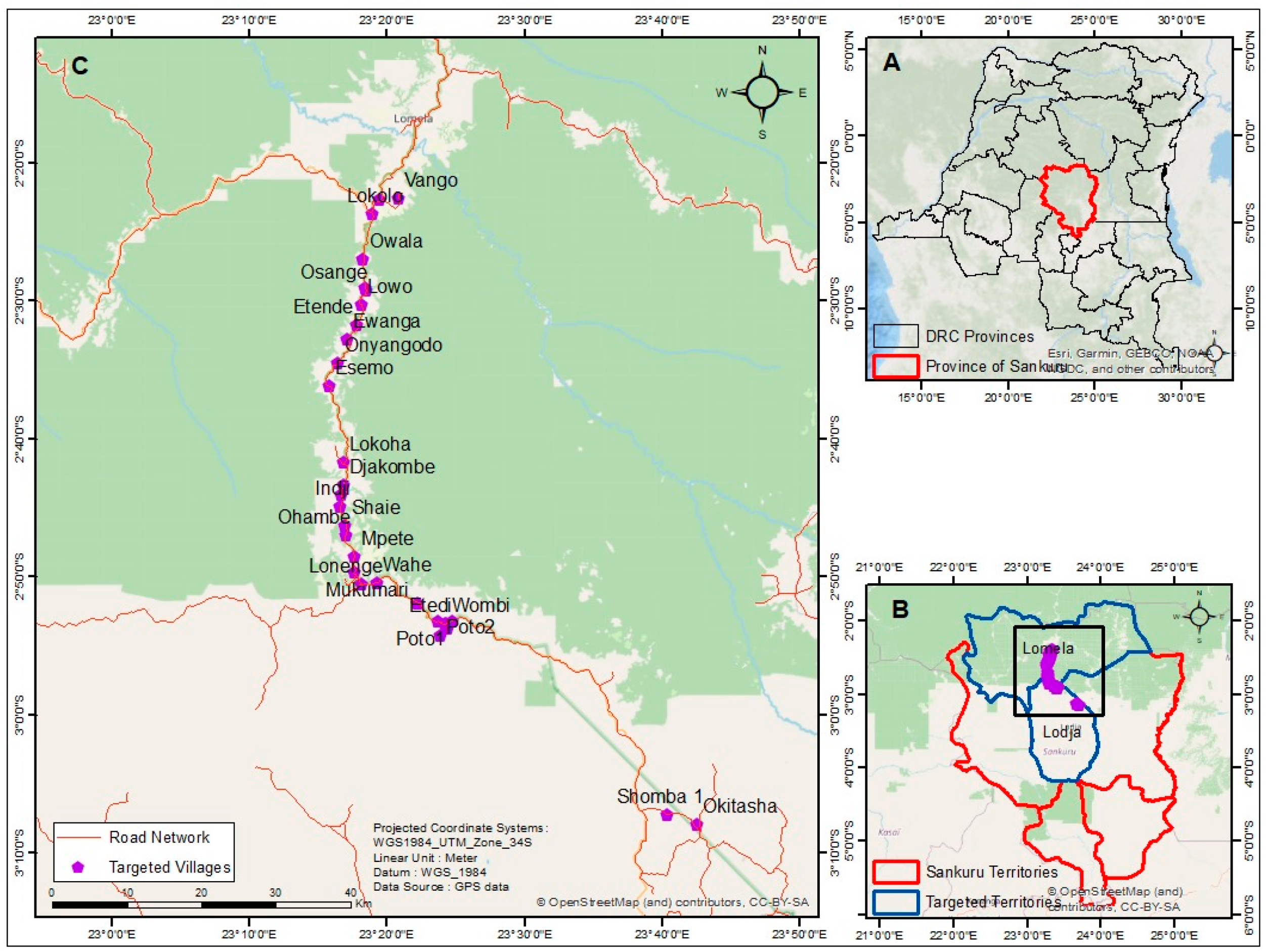

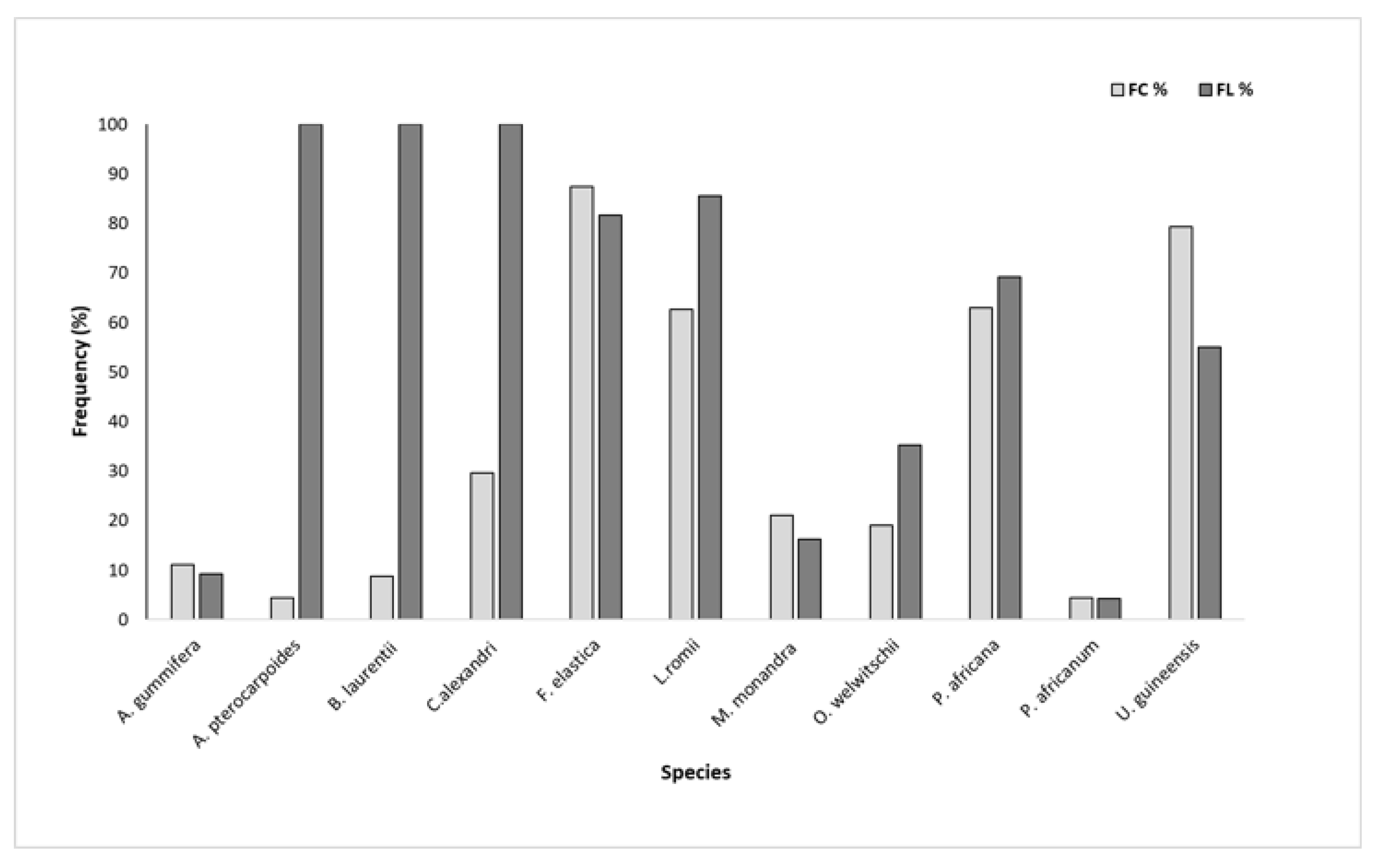

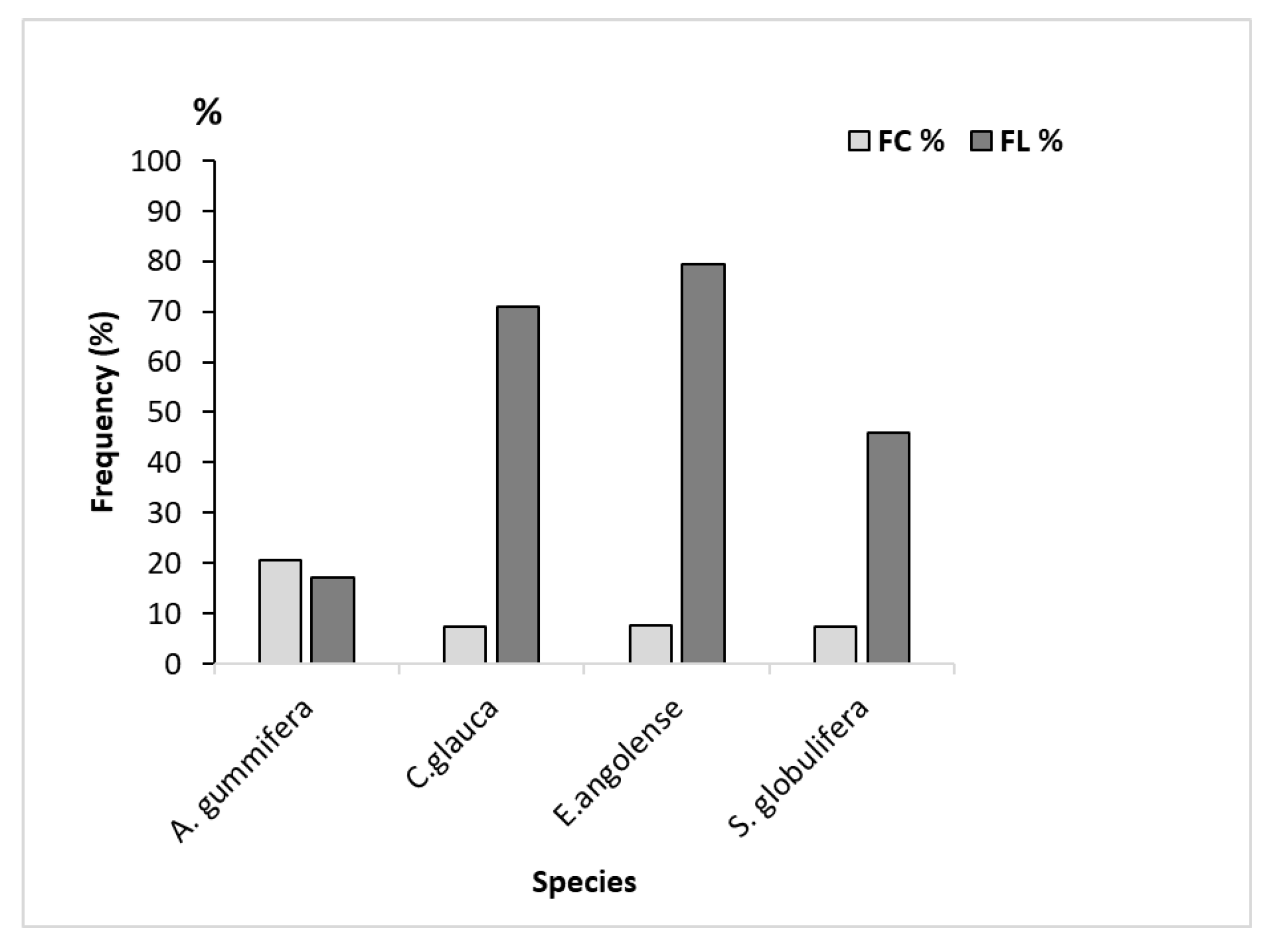

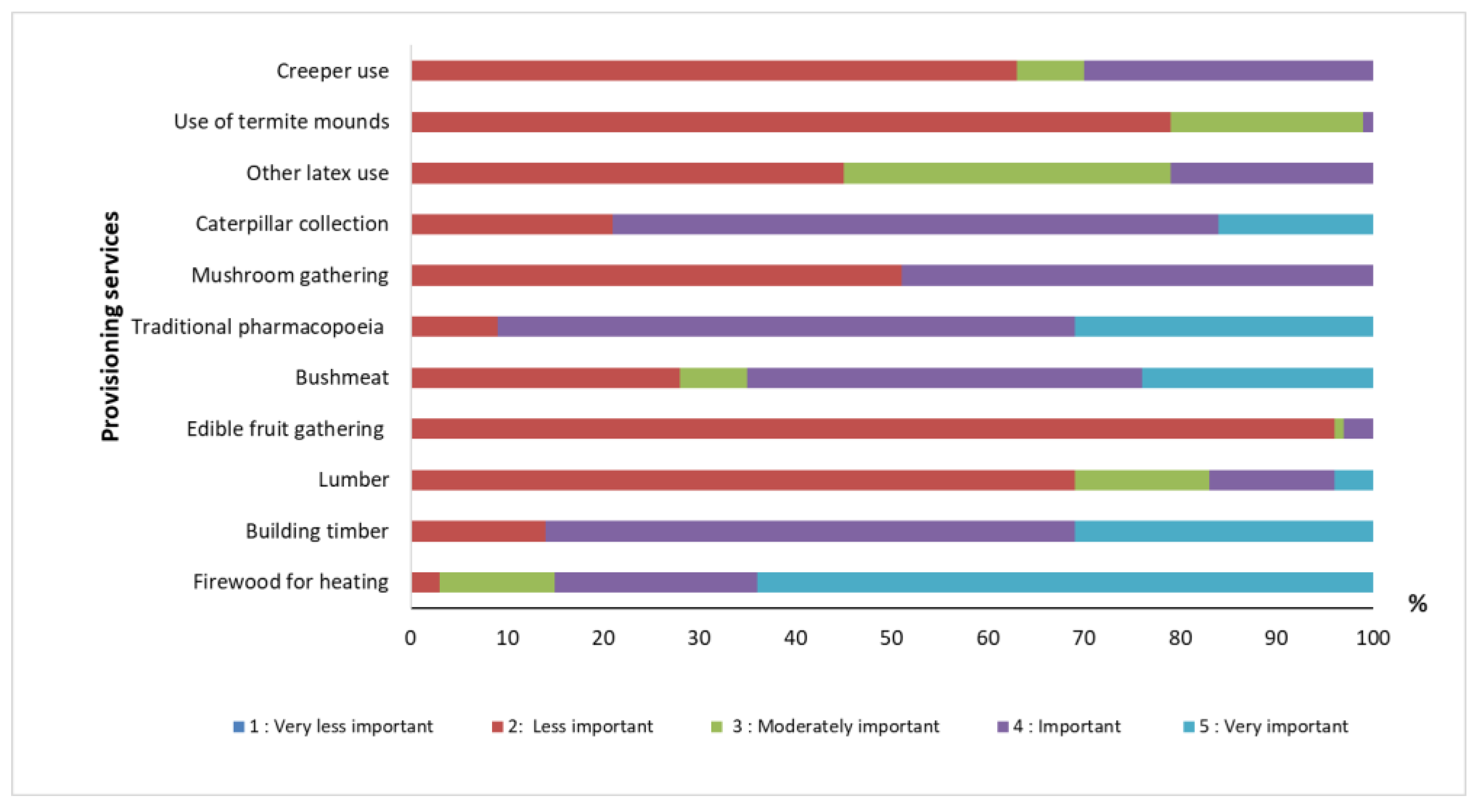
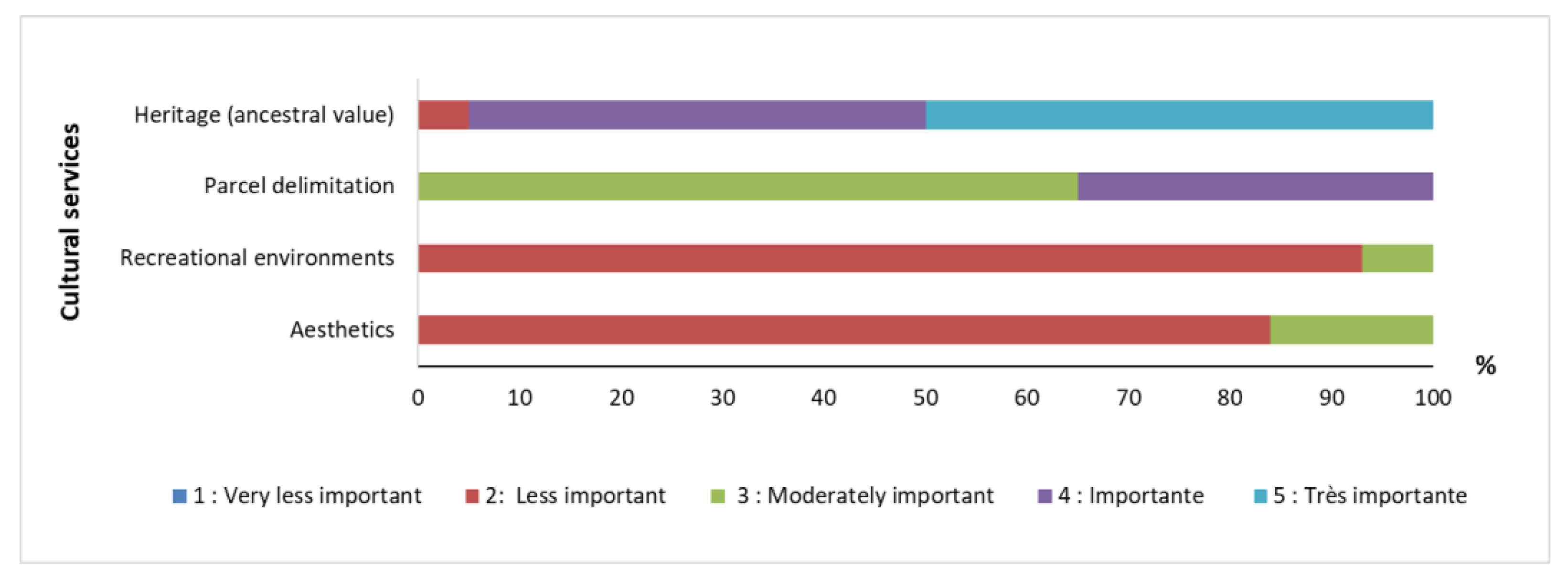

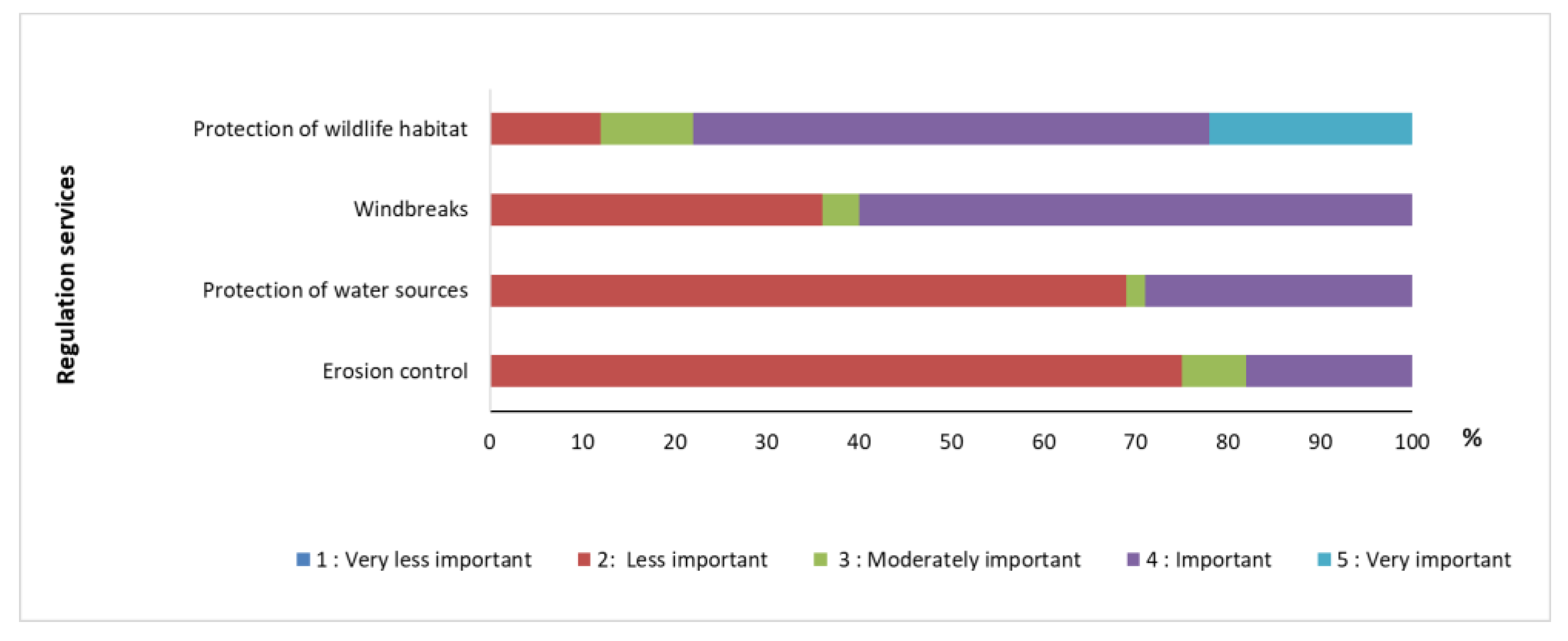
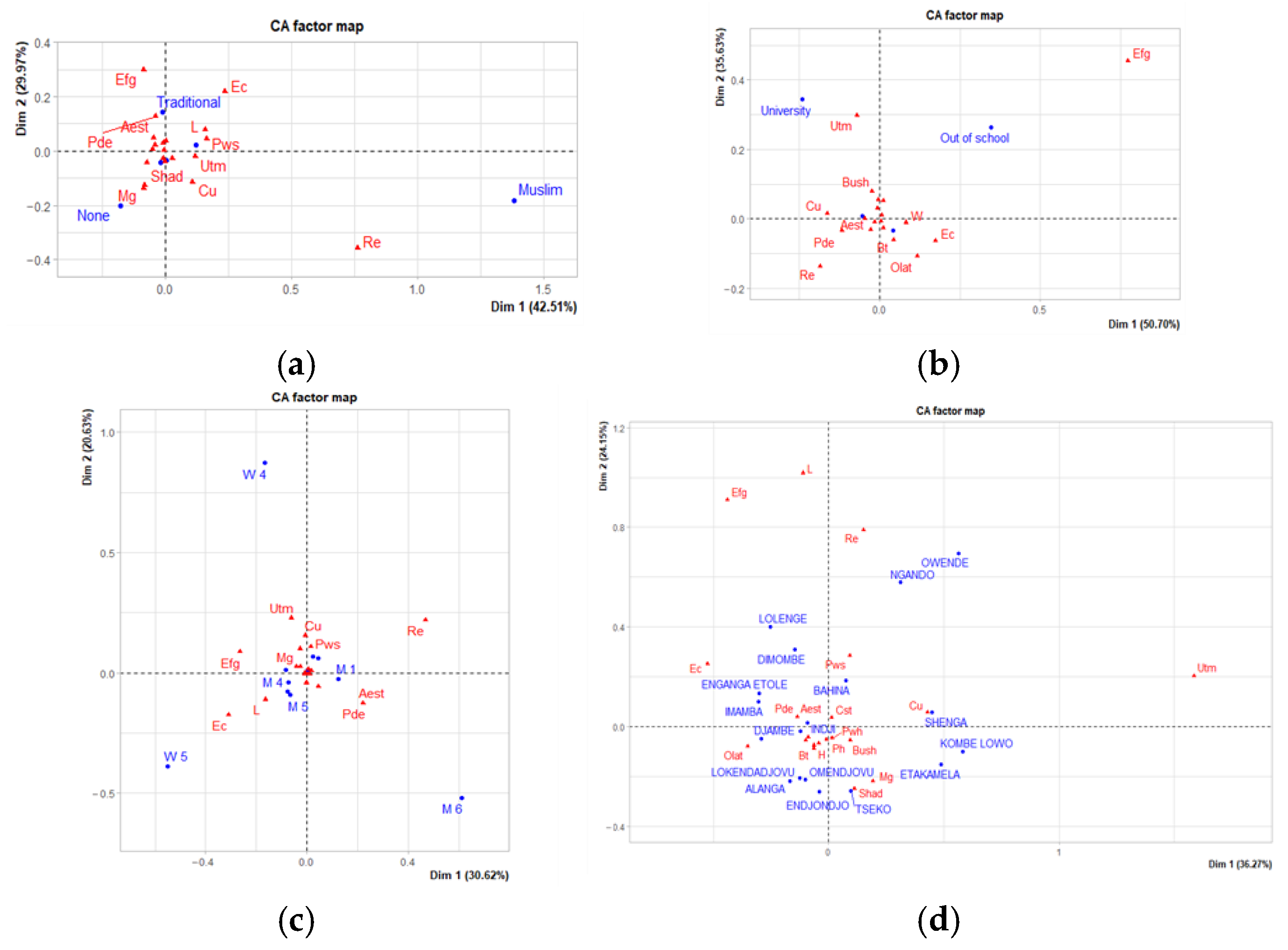
| Territory | Lomela | Lodja | Total | ||
|---|---|---|---|---|---|
| Sector | Bahamba I | Batetela | Ahamba Mange | Vungi | |
| Distribution (%) | 62 | 6 | 28.3 | 3.7 | 100 |
| Number of villages | 18 | 2 | 8 | 2 | 30 |
| Number of Households surveyed | 186 | 18 | 85 | 11 | 300 |
| Variables | Number | Percentage | |
|---|---|---|---|
| Gender | Female | 76 | 25.33 |
| Male | 224 | 74.67 | |
| Age | [20–30] | 82 | 27.33 |
| [31–40] | 99 | 33.00 | |
| [41–50] | 78 | 26.00 | |
| [51–60] | 29 | 9.67 | |
| [61–70] | 11 | 3.67 | |
| ≥70 years | 1 | 0.33 | |
| Tribe | Ahamba | 85 | 28.33 |
| Bahamba | 186 | 62.00 | |
| Batetela | 18 | 6.00 | |
| Vunge | 11 | 3.67 | |
| Education level | Primary | 149 | 49.67 |
| Secondary | 139 | 46.33 | |
| University | 5 | 1.67 | |
| Out of school | 7 | 2.33 | |
| Marital status | Married | 277 | 92.33 |
| Single | 18 | 6.00 | |
| Widowed | 5 | 1.67 | |
| Household size | [0–5] | 68 | 22.67 |
| [6–10] | 150 | 50.00 | |
| [11–15] | 68 | 22.67 | |
| [16–20] | 10 | 3.33 | |
| ≥21 | 4 | 1.33 | |
| Religion | Catholic | 77 | 25.67 |
| Kimbanguism | 24 | 8.00 | |
| Protestant | 131 | 43.67 | |
| Traditional | 62 | 20.67 | |
| Islam | 1 | 0.33 | |
| None | 5 | 1.67 | |
| Energy source | Wood | 300 | 100 |
| Man activities | Salaried activities | 15 | 5.00 |
| Farming | 300 | 100 | |
| Hunting | 182 | 60.67 | |
| Fishing | 156 | 52.00 | |
| Fish farming | 124 | 41.33 |
| Services Category | Used Citation (Nur) | % Used Expressions | Number of Species (Nt) | ICF |
|---|---|---|---|---|
| Firewood for heating | 290 | 96.67 | 11 | 0.97 |
| Building timber | 257 | 85.67 | 12 | 0.96 |
| Lumber | 94 | 31.33 | 4 | 0.97 |
| Traditional pharmacopoeia | 274 | 91.33 | 26 | 0.91 |
| Caterpillar collection | 238 | 79.33 | 7 | 0.97 |
| Family | Genres | Species | ES Category | UV |
|---|---|---|---|---|
| Annonaceae | Cleistopholis | Cleistopholis glauca Pierre ex Engl. & Diels | Bo, Ph | 0.10 |
| Xylopia | Xylopia cupularis Mildbr. | Ph | 0.13 | |
| Apocynaceae | Alstonia | Alstonia congensis Engl. | Ph | 0.09 |
| Funtumia | Funtumia elastica (P. Preuss) Stap | Bch, Bc, Ph | 1.07 | |
| Bombacaceae | Ceiba | Ceiba pentandra (L.) Gaertn. | Ph | 0.10 |
| Burseraceae | Canarium | Canarium schweinfurthii Engl. | Ph | 0.05 |
| Caesalpiniaceae | Cynometra | Cynometra alexandri C. H. Wright | Bch | 0.30 |
| Clusiaceae | Mammea | Mammea africana Sabine | Ph | 0.11 |
| Garcinia | Garcinia kola Heckel | Ph | 0.52 | |
| Garcinia punctata Oliv. | Bc | 0.46 | ||
| Symphonia | Symphonia globulifera L.f. | Bc, Bo | 0.16 | |
| Dracaenaceae | Sansevieria | Sansevieria liberica Gérôme & Labroy | Ph | 0.02 |
| Ebenaceae | Diospyros | Diospyros alboflavescens (Gürke) F.White | Bc | 0.45 |
| Euphorbiaceae | Macaranga | Macaranga monandra Müll.Arg. | Bch, Bc, Ph | 1.30 |
| Plagiostyles | Plagiostyles africana (Müll.Arg.) Prain | Bch, Bc, Ph | 0.91 | |
| Croton | Croton mubango Müll.Arg. | Ph | 0.26 | |
| Uapaca | Uapaca guineensis Müll. Arg. | Rche, Bch | 1.44 | |
| Grossera | Grossera macrantha Pax | Bc | 0.09 | |
| Fabaceae | Albizia | Albizia gummifera (J.F.Gmel.) C.A.Sm. | Rche, Bch, Bo, Ph | 1.20 |
| Erythrophleum | Erythrophleum suaveolens (Guill. & Perr.) Brenan | Rch | 0.82 | |
| Leonardoxa | Leonardoxa romii (De Wild.) Aubrév. | Bch, Bc | 0.73 | |
| Brachystegia | Brachystegia laurentii (De Wild.) Louis ex Hoyle | Bch | 0.09 | |
| Fabaceae-Caesalpiniaceae | Scorodophloeus | Scorodophloeus zenkeri Harms | Ph | 0.08 |
| Gilbertiodendron | Gilbertiodendron dewevrei (De Wild.) J. Léonard | Ph | 0.02 | |
| Fabaceae-Faboideae | Amphimas | Amphimas ferrugineus Pierre ex Pellegr. | Rche | 1.00 |
| Amphimas pterocarpoides Harms | Bch | 0.04 | ||
| Fabaceae-Mimosoideae | Tetrapleura | Tetrapleura tetraptera (Schumach. & Thonn.) Taub. | Ph | 0.04 |
| Pentaclethra | Pentaclethra macrophylla Benth. | Ph | 0.26 | |
| Piptadeniastrum | Piptadeniastrum africanum (Hook. f.) Brenan | Rche, Bch, Ph | 1.93 | |
| Flacourtiaceae | Oncoba | Oncoba welwitschii Oliv. | Rche, Bch, Bc | 0.54 |
| Huaceae | Afrostyrax | Afrostyrax lepidophyllus Mildbr. | Ph | 0.11 |
| Lecythidaceae | Petersianthus | Petersianthus macrocarpus (P. Beauv.) Liben | Rche, Bc, Ph | 1.95 |
| Meliaceae | Carapa | Carapa procera DC. | Ph | 0.09 |
| Entandrophragma | Entandrophragma angolense (Welw.) C. DC. | Bo, Ph | 0.10 | |
| Myristicaceae | Staudtia | Staudtia kamerunensis var. gabonensis (Warb.) Fouilloy | Bc | 0.42 |
| Rhamnaceae | Maesopsis | Maesopsis eminii Engl. | Ph | 0.15 |
| Rubiaceae | Aidia | Aidia Micrantha (K. Schum.) F. White | Bc, Ph | 0.15 |
| Morinda | Morinda morindoides (Baker) Milne-Redh. | Ph | 0.18 | |
| Urticaceae | Myrianthus | Myrianthus arboreus P.Beauv. | Ph | 0.03 |
| Familly | Species | Local Name | ES Category | UV |
|---|---|---|---|---|
| Auriculariaceae | Auricularia cornea Ehrenb. (1820) | Atole | Rcha | 0.87 |
| Cantharellaceae | Cantharellus congolensis Beeli (1928) | Dongono | Rcha | 0.88 |
| Lyophyllaceae | Termitomyces globulus R. Heim & Gooss.-Font | Etolo | Rcha | 0.12 |
| Termitomyces microcarpus (Berk. & Br.) Heim (1942) | Kokalokonda | Rcha | 0.05 | |
| Marasmiaceae | Marasmius bekolacongoli Beeli (1928) | Lombadu | Rcha | 0.03 |
| Polyporaceae | Lentinus squarrosulus Mont. (1842) | Koyo | Rcha | 0.05 |
| Lentinus brunneofloccosus Pegler (1971) | Mbadu | Rcha | 0.94 | |
| Schizophyllaceae | Schizophyllum commune Fr. (1815) | Tshukunu | Rcha | 0.84 |
| Species | Commercial Name | Local Name | Type | UV |
|---|---|---|---|---|
| Cricetomys gambianus | Gambia Rat | Otomba | Rodent | 0.52 |
| Dendrohyrax dorsalis | Tree Daman | Mende | Mammal | 0.16 |
| Hystrix africaeaustralis | Porcupine | Eko | Rodent | 0.72 |
| Manis spp. | Pangolin | Loka | Mammal | 0.22 |
| Nesotragus spp. | Antelope | Mengela | Mammal | 0.48 |
| Philantomba monticola | Blue duiker | Mboloko | Mammal | 0.53 |
| Potamochoerus spp. | Boar | Sombo k’okonda | Mammal | 0.01 |
| Serpentes spp. | Snake | Oloyi | Reptile | 0.23 |
| Simiiformes spp. | Monkey | Kema | Mammal | 0.18 |
| Species | Local Name | FC% | NF% | Parts Used | Medical Uses |
|---|---|---|---|---|---|
| Cleistopholis glauca Pierre ex Engl. & Diels | Otole | 3 | 29 | Gum, leaves, bark | Wounds, boils, fever |
| Xylopia cupularis Mildbr. | Owelewele | 13 | 100 | Leaves, seeds | Stomachache, diarrhea |
| Alstonia boonei Engl. | Okuka | 9 | 100 | Leaves, bark | Diarrhea, dysmenorrhea |
| Funtumia elastica (P. Preuss) Stap | Osomba | 11 | 10 | Bark | Stomach pain |
| Ceiba pentandra (L.) Gaertn. | Otamba | 10 | 100 | Seeds, bark | Cough, ascites, pneumopathy, epileptiform seizures |
| Canarium schweinfurthii Engl. | Owole | 5 | 100 | Bark | Dysentery |
| Mammea africana Sabine | Okodi | 11 | 100 | Seed, bark | Burns, syphilis |
| Garcinia kola Heckel | Otendo | 52 | 100 | Seed, bark | Cough, hypertension |
| Sansevieria liberica Gérôme & Labroy | Lokoto | 2 | 100 | Leaves | Rheumatism |
| Macaranga monandra Müll.Arg. | Oloko | 82 | 63 | Leaves, bark | Migraines |
| Plagiostyles africana (Müll.Arg.) Prain | Onenge | 17 | 19 | Cambium, bark | Earaches, venereal diseases |
| Croton mubango Müll. Arg. | Onyanga | 26 | 100 | Bark | Splenomegaly, tuberculosis |
| Albizia gummifera (J.F.Gmel.) C. A. Sm. | Owamba | 2 | 2 | Leaves, bark | Venereal diseases, asthma, wounds |
| Scorodophloeus zenkeri Harms | Ohidi | 8 | 100 | Bark | Skin rashes, splenomegaly |
| Gilbertiodendron dewevrei (De Wild.) J. Léonard | Wete | 2 | 100 | Bark | Otitis, gastritis |
| Tetrapleura tetraptera (Schumach. & Thonn.) Taub. | Olese | 4 | 100 | Fruit | Asthma |
| Pentaclethra macrophylla Benth. | Owala | 26 | 100 | Seed, bark | Hypertension, rheumatism, hemorrhoids, constipation |
| Piptadeniastrum africanum (Hook. f.) Brenan | Okungu | 98 | 96 | Bark | Tooth decay, splenomegaly, convulsions, pelvic pain |
| Afrostyrax lepidophyllus Mildbr. | Ongenge | 11 | 100 | Leaves, bark | Hernia, psychosomatic disorders |
| Petersianthus macrocarpus (P. Beauv.) Liben | Too | 82 | 42 | Leaves, bark | Anemia, antispasmodic, anti-inflammatory, venereal diseases |
| Carapa procera DC. | Bolokoto | 9 | 100 | Leaves, bark, roots | Hypertension, diabetes, pharyngitis |
| Entandrophragma angolense (Welw.) C. DC. | Pake | 2 | 21 | Bark | Ulcers |
| Maesopsis eminii Engl. | Osungu | 15 | 100 | Bark | gonorrhea, constipation, splenomegaly, and verminosis |
| Aidia Micrantha (K. Schum.) F. White | Kendju | 6 | 41 | Leaves, roots | Trypanosomiasis |
| Morinda morindoides (Baker) Milne-Redh. | Kongo bololo | 18 | 100 | Leaves, roots | Gonorrhea, hemorrhoids, lumbago |
| Myrianthus arboreus P. Beauv. | Okumu | 3 | 100 | Leaves, bark | Paralysis, epilepsy, convulsions |
Disclaimer/Publisher’s Note: The statements, opinions and data contained in all publications are solely those of the individual author(s) and contributor(s) and not of MDPI and/or the editor(s). MDPI and/or the editor(s) disclaim responsibility for any injury to people or property resulting from any ideas, methods, instructions or products referred to in the content. |
© 2025 by the authors. Licensee MDPI, Basel, Switzerland. This article is an open access article distributed under the terms and conditions of the Creative Commons Attribution (CC BY) license (https://creativecommons.org/licenses/by/4.0/).
Share and Cite
Mobunda Tiko, J.; Ndjadi, S.S.; OBANDZA - AYESSA, J.L.; Banga, D.B.; Balandi, J.B.; Musavandalo, C.M.; Mweru, J.P.M.; Michel, B.; Rakotondrasoa, O.L.; To Hulu, J.P.M. Farmers’ Perception of Ecosystem Services Provided by Historical Rubber Plantations in Sankuru Province, DR Congo. Conservation 2025, 5, 7. https://doi.org/10.3390/conservation5010007
Mobunda Tiko J, Ndjadi SS, OBANDZA - AYESSA JL, Banga DB, Balandi JB, Musavandalo CM, Mweru JPM, Michel B, Rakotondrasoa OL, To Hulu JPM. Farmers’ Perception of Ecosystem Services Provided by Historical Rubber Plantations in Sankuru Province, DR Congo. Conservation. 2025; 5(1):7. https://doi.org/10.3390/conservation5010007
Chicago/Turabian StyleMobunda Tiko, Joël, Serge Shakanye Ndjadi, Jémima Lydie OBANDZA - AYESSA, Daniel Botshumo Banga, Julien Bwazani Balandi, Charles Mumbere Musavandalo, Jean Pierre Mate Mweru, Baudouin Michel, Olivia Lovanirina Rakotondrasoa, and Jean Pierre Meniko To Hulu. 2025. "Farmers’ Perception of Ecosystem Services Provided by Historical Rubber Plantations in Sankuru Province, DR Congo" Conservation 5, no. 1: 7. https://doi.org/10.3390/conservation5010007
APA StyleMobunda Tiko, J., Ndjadi, S. S., OBANDZA - AYESSA, J. L., Banga, D. B., Balandi, J. B., Musavandalo, C. M., Mweru, J. P. M., Michel, B., Rakotondrasoa, O. L., & To Hulu, J. P. M. (2025). Farmers’ Perception of Ecosystem Services Provided by Historical Rubber Plantations in Sankuru Province, DR Congo. Conservation, 5(1), 7. https://doi.org/10.3390/conservation5010007






